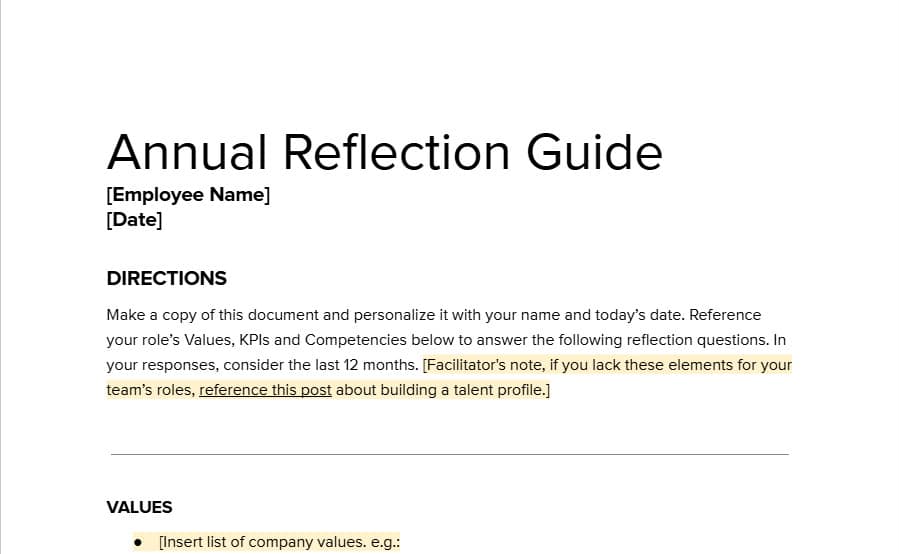A year ago, I set out to create an annual managerial feedback process to help my team reflect, align, and grow. I already hosted monthly one-on-ones for ongoing support, but these yearly syncs were meant to zoom out: a chance to assess strengths, chart growth, and identify areas to level up.
My Plan: Simple and Smart
To organize the feedback, I thought it would be smart to create a list of the core competencies of each team member’s role. Then, independently, they could assess their own performance, and I would do the same. Lastly, we would meet, compare notes, and gain alignment.
So I turned to my trusty talent profile for each team member, and I listed the values, key performance indicators (KPIs), and competencies for each role. I then assigned the work of self-assessing and asked them to come prepared with stories or examples to support their rating. For each ingredient of the job, the team member and I would assign them a simple “check,” “check minus,” and “check plus.”
In my mind, this was an objective, quantifiable, and transparent method to develop shared understanding and provide managerial feedback my team needed for their growth.
What Actually Happened: Awkwardness Galore
Spoiler: it didn’t work.
The self-assessments quickly became a game of interpretation. We were using the same scales but talking about entirely different examples. A check-plus for me meant one thing; for my team, it meant another.
Worse, instead of alignment, these meetings left us more confused than when we started. We spent too much time debating grades and too little exploring the stories behind them.
The Flattened Flaw
When I shared my struggles with a mentor, they laughed and said, “You’re trying to flatten knowledge work like it’s an assembly line.”
Bingo. Knowledge work is messy, nuanced, and interconnected. Flattening it to a few checkmarks took the medium away from the message.
The Fix: Flipping the Format
When I brought this dilemma to my colleague John, he had a game-changing suggestion: ditch the grades. Instead, use our values, KPIs, and competencies as prompts for open-ended reflection. In this way, I was flipping the KPIs, values, and competencies from being the prompts for the questions to making them the answers to broader questions.
Instead of checking boxes, the team could share examples of when they nailed it, when they struggled, and where they see room to grow. It kept the good parts — specific stories and rich conversations — without the rigid scoring system that derailed us.
Want to Try It?
I’ve created a Google template you can steal. Plug in your KPIs, values, and competencies, and use the template to spark thoughtful reflection and meaningful feedback discussions.
If your team doesn’t have a regular feedback rhythm, this is a great place to start. Feedback is too important to leave to chance — or bad systems.

